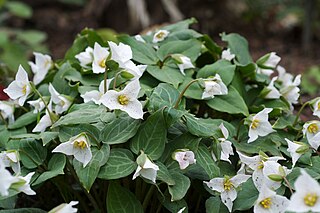
Pseudotrillium is a monotypic genus of flowering plants in the family Melanthiaceae containing the single species Pseudotrillium rivale. The genus was proposed in 2002 on the basis of morphology and molecular evidence that suggest the plant should no longer be included in genus Trillium.

Vaccinium uliginosum is a Eurasian and North American flowering plant in the genus Vaccinium within the heath family.
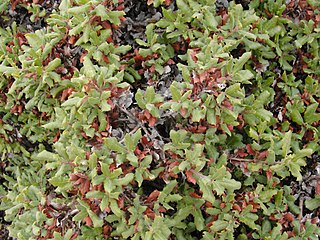
Quercus durata, the California scrub oak, or leather oak, is an oak endemic to California.
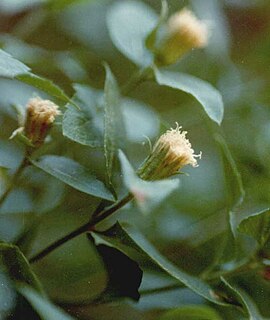
Ageratina shastensis is a species of snakeroot which is endemic to Shasta County, California. It is known by the common names Mt. Shasta snakeroot and Shasta eupatorium.

Quercus dumosa is a species of plant in the family Fagaceae, belonging to the white oak section of the oak genus (Quercus). This tree goes by the common names coastal sage scrub oak and Nuttall's scrub oak.
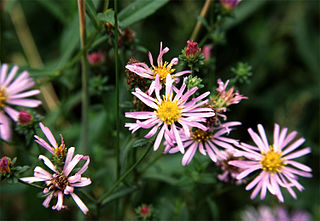
Symphyotrichum chilense is a species of aster known by the common names Pacific aster and common California aster.
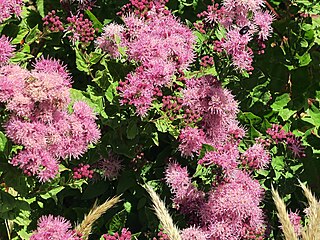
Ageratina occidentalis is a species of flowering plant in the daisy family known by the common name western snakeroot or western eupatorium. It is native to the western United States where it grows in several types of habitat. It is found in California, Oregon, Washington, Idaho, Montana, Nevada, and Utah.

Allium yosemitense is a California species of wild onion known by the common name Yosemite onion. Most of the known populations are situated within the boundaries of Yosemite National Park.

Balsamorhiza deltoidea is a species of flowering plant in the sunflower tribe of the plant family Asteraceae known by the common name deltoid balsamroot. It is native to western North America from British Columbia to California, where it grows in many types of generally mountainous habitat.
Balsamorhiza macrolepis is a species of flowering plant in the sunflower tribe of the aster family, known by the common name California balsamroot. It is found only in California, where it grows in dry, open habitat, mostly in mountainous areas, mostly in the western foothills of the Sierra Nevada and in the eastern Coast Ranges near San Francisco Bay. It is now becoming rare in the Coast Ranges.

Balsamorhiza sericea is a species of flowering plant in the sunflower tribe of the plant family Asteraceae known by the common name silky balsamroot. It is native to the Klamath Mountains of northwestern California and southwestern Oregon, with additional populations in the Blue and Steens Mountains in eastern Oregon. It grows in rocky areas, sometimes on serpentine soils.
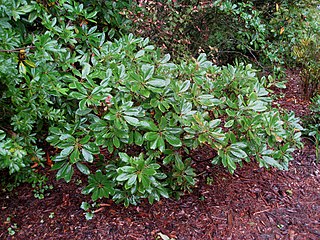
Quercus sadleriana is a species of oak known by the common names Sadler's oak and deer oak. It is native to southwestern Oregon and far northern California in the Klamath Mountains. It grows in coniferous forests.
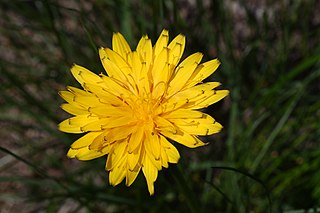
Nothocalais alpestris is a species of flowering plant in the aster family known by the common name alpine lake false dandelion. It is native to the Cascade Range, Sierra Nevada and other mountains from northern Washington to central California, where it grows in subalpine forests and meadows, most commonly at 1,200–2,700 m (4,000–9,000 ft) elevation.

Quercus cornelius-mulleri is a North American species of oak known by the common name Muller oak, or Muller's oak. It was described to science in 1981 when it was segregated from the Quercus dumosa complex and found to warrant species status of its own. It was named after the ecologist Cornelius Herman Muller. It is native to southern California and Baja California, where it grows in chaparral, oak woodlands, and other habitat in foothills and mountains. It can most easily be observed in Joshua Tree National Park and in the woodlands along the western margins of the Colorado Desert in San Diego County, California.

Quercus john-tuckeri is a North American species of oak known by the common name Tucker oak, or Tucker's oak. It is endemic to California, where it grows in the chaparral and oak woodlands of mountain slopes in the western Transverse Ranges, the southernmost Central Coast Ranges, and the margins of the Mojave Desert. The species is named after John M. Tucker, professor of botany (1947-1986) at the University of California at Davis, specialist in Quercus.

Quercus turbinella is a North American species of oak known by the common names shrub oak, turbinella oak, shrub live oak, and gray oak. It is native to Arizona, California, New Mexico, Utah, Colorado, and Nevada in the western United States. It also occurs in northern Mexico.

Quercus pacifica is a species of oak known by the common names island scrub oak, Channel Island scrub oak, and Pacific oak.

Ageratina luciae-brauniae is a species of flowering plant in the aster family known by the common names Lucy Braun's snakeroot and rockhouse white snakeroot. It is native to the eastern United States, where it is limited to the Cumberland Plateau of Kentucky and Tennessee. It may also occur in South Carolina but these reports are unconfirmed.

Drymocallis glandulosa, known by the common name sticky cinquefoil and formerly as Potentilla glandulosa, is a plant species in the family Rosaceae.
Balsamorhiza lanata, with the common name lanate balsamroot, is a species of plant in the sunflower tribe of the aster family native to California.



















